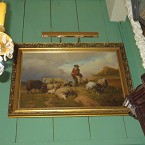








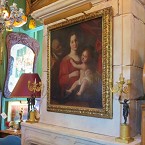

















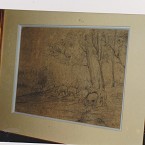






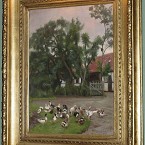




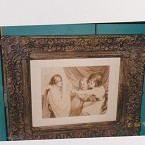

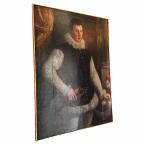






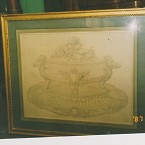















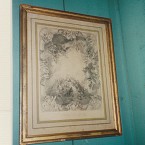
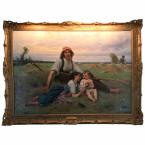









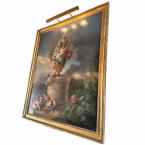
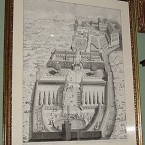
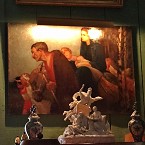

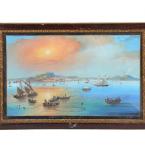



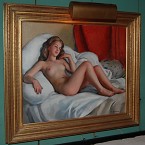














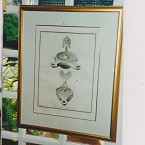




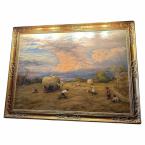




















Height 28 inches
Width 24 inches
After his training in Amsterdam with François Boitard and
Bernard Picart, Jacques Aved started working in Paris for Belle in 1721. He later
entered at the Royal Academy of Painting and Sculpture Académie royale de
peinture et de sculpture in 1731 and he was appointed councilor after
graduating in 1734 and in 1759, he took part in his last salon. In 1753 he
became a member of the Confrerie Pictura
As an art dealer and collector, he owned one of the most
important collections with works by Italian French and especially Dutch artists
. This collection was sold at auction in 1766 . Carle Van Loo , François
Boucher , Dumont le Romain and Chardin were some of his pupils.
This incredible Artwork painting would be beautiful addition
to collectors or to decorate a law office a library , Hallway , Living room a
man's room or as a great elegant gift idea for an office space and house
warming . Antique dealer West Hollywood Melrose Ave La Cienega Blvd . On top of
a dresser a semainier a secretaire or in the background of your desk , this
outstanding painting with the hand carved wood gilt frame will be the touch of
old world adding the charm history and elegance to your decore .
This beautiful portrait of a gentleman is very versatile and
can go with any design, rustic farm , elegant space , formal setting , modern
or old world European charm . overall good shape, recanvassing so many of the
wonderful Art and with a Chateau inventory number that is still on the back
with number 16935 tag

18th C. School Jean Baptiste Greuze Peasant Child in a white
bonnet antiques LA . This exceptional painting of a peasant child in a white
Bonnet is a fine example of the style of Jean Baptiste Greuze, a very well
known and respected French painter of the 18th century.
Although unsigned, this work can be dated to the Greuze
period and contains many of the elements which the artist is known for. The
painting, if not by the hand of Greuze, is mot definitely by one of his close
students. Framed in nicely gilt and decorated wood frame. Documents from the
Metropolitan Museum of Art New York.
The picture of a young peasant is usually referred to as an
allegory of "Innocence," traditionally been equated with a sense of
innocence, gentleness, patience and humility. With such iconography in the
present picture, Greuze thus injects the female sitter with the same
characteristics. The depiction of young women tenderly and calmly sitting,
insinuating their ability to show tender emotion, relates to the 18th century
cult of sensibilité developed by Rousseau and his circle. Greuze's subject thus
appears infused with the subtle combination of sexual innocence and emotional
depth. Same applied to his circle.
This type of subject, employing young girls in various
emotional states, reached its peak in Greuze's career during the 1780s, thus
his circle as well.
Jean Baptiste Greuze was born at Tournus on Aug. 21, 1725.
His early life is undocumented, but he studied painting in Lyons and appeared
in Paris around 1750. He entered the Royal Academy as a student and worked with
Charles Joseph Natoire, a prominent decorative painter. During the 1760's Greuze
achieved a significant reputation with his sentimental paintings of peasants or
lower-class people seen in humble surroundings and in the midst of theatrically
emotional family situations; examples are The Village Bride (1761), The
Father's Curse (1765), and The Prodigal Son (1765).
In 1769 Greuze was admitted to the academy as a genre
painter. Ambitious to become a member of the academy as a history painter,
which was a higher rank, he was so angered by his admission as only a genre
painter that he refused to show his paintings at the academy's exhibitions (the
Salons). However, by that time he was already famous and could afford to ignore
the Salons.
The rising importance of the middle class, and of
middle-class morality, also played a part in the success of Greuze's cottage
genre. His work seemed to preach the homely virtues of the simple life, a
"return to nature," and the honesty of unaffected emotion. The
blatant melodrama of his preaching was not found offensive, and visitors to the
Salons wept in front of his paintings. The intellectuals of the day were
generally opposed to the rococo as a decadent style; rather paradoxically,
Greuze's most influential champion was Denis Diderot, one of the leading
philosophers of the Enlightenment, who hailed Greuze as "the painter of
virtue, the rescuer of corrupted morality." The fashion for simplicity and
the "natural man" penetrated the highest circles, and engravings of
Greuze's work were popular with all classes of society.
In terms of style, Greuze has been linked to neoclassicism.
The complexity of his compositions, however, and his interest in surface
textures place him within the general stylistic pattern of his period. In his
sensual paintings of girls (such as The Morning Prayer and The Milkmaid), with
their veiled eroticism, pale colors, and soft tonality, his connection with the
rococo is most evident. Some of Greuze's best work is to be seen in his portraits
(for example, Étienne Jeaurat), which are often sensitive and direct. Greuze
survived the French Revolution but his fame did not. He died in Paris on March
21, 1805, in poverty and obscurity.

A
Beautiful 18th Century Italian School
“The
Holy Family” painting.
Oil
on Canvas With Original Frame
Height: 40"
Width: 34"


19th C.
Orientalist Painting Pastel Arab and Camel, desert landscape fauna Flora . Beautiful
and fine 19th century orientalist Pastel painting of an Arab Man with his camel
traveling in the desert looking into the pink glow of the sun. In gilt frame. which depicts a group of people in the distance around their
tents , resting across a desert landscape with what must be the Badiya is a
region of desert or semi-desert and steppe of the Middle East, including parts
of southern Syria, eastern Jordan, northern Saudi Arabia, and western Iraq. People
of the region would be wrapped in light-colored clothing to
protect against the harsh desert weather conditions as depicted in this
painting.
The Artist has
masterfully painted this picture with the natural landscape with Desert Flowers
calligonum comosum that Helps Stabilize Sand Dunes. Amongst some other plants
that can survive the harsh temperature of the area, with some Date trees that
are full of fruits . Signs of Age as seen in the pictures, you are welcome to
see it in person or send your expert.
A dynamic
sense of movement that helps to create the illusion of spatial depth. The
desert landscape, as a result, appears vast and magnificent. ‘Crossing the
Desert’ is also a technical masterpiece. The landscape and figures within it
are naturalistically portrayed, with every detail carefully rendered. This beautiful
orientalist painting will elevate your interior design with a splash of color. the
perfect magic touch to a library, a bedroom wall, living dining room. To
decorate the wall on top of a console or credenza. On top of a fireplace mantel
(fireplace) and entry way etc. 'Orientalism' refers to the representation of
the East in Western art which often blurred the line between fantasy and
reality. The Orientalist art movement reached its height during the 19th
century and is perhaps best known today for its production of impressive oil
paintings and works on paper. These paintings were popular in the 19th century,
as Europeans and North Americans increasingly turned their attentions to
cultures overseas. The works were mostly by male Western artists, made to
satisfy an enormous public interest in the lands of the Middle East and North
Africa.
Many artists
travelled to the places they depicted, whether Constantinople, Jerusalem, Cairo
or Marrakesh. Others travelled no further than Paris or Vienna, using a mixture
of photographs, props and imagination for inspiration. Recurring images
included everything from detailed sketches of everyday life to highly
imaginative scenes of the harem. Interest in Orientalism developed in tandem
with European colonial activity, which allowed soldiers, traders and artists
greater access to the places and peoples of these regions. An important function of Orientalist
painting was to create a visual record of places of interest. Such images were
aimed at a growing market of Europeans and North Americans who either visited
the Middle East and North Africa or were interested in the regions from afar.
Travel was made easier by steamships and trains, so paintings tended to focus
on cities, such as Constantinople, Cairo and Marrakesh, the arrival points for
artists and their potential customers alike. Some images depicted sites of religious
importance, both Christian and Muslim, while others captured the ancient sites
of pre-Islamic history
The absence
of a condition statement does not imply that the lot is in perfect condition or
completely free from wear and tear, imperfections or the effects of aging. To
sending your expert to create an independent Condition report , by appointment
only at la maison francaise antiques.
Any condition statement given, as a courtesy to a client, is only an
opinion and should not be treated as a statement of fact. Lamaisonfrancaise,
Inc. shall have no responsibility for any error or omission.














Black Chalk on blue paper 17 ½” X 12” Framed 25” height, and 22” width. almost 3” thick
Note on the back: This drawing is in the manner of Pietro De
Pietri (1663-1716). See “Roman Drawings At Windsor Castle” Page 08-FIG.68. It
is Possible That Parry Studied The Pietri Drawing At Windsor, & was
Influenced By it. Joseph Parry
(1756–1826) was a British painter and engraver. He was popularly known by his
contemporaries as Old Parry to distinguish him from his sons James Parry (1795
– 1877) was a British painter and engraver and David Henry Parry, also artists.
Parry had a significant role in the development of
Manchester as a center of the arts due to both his mentorship of younger
artists and his direct influence on their artistic styles, and he is often
referred to as "the Father of Art in Manchester" (or variations
thereon) by both his contemporaries and later historians
By the 1820s, Manchester's art market had matured enough
that dealers were bringing significant works from London and abroad to sell,
and a generation of Manchester-based artists had emerged who felt that the city
needed its own counterpart to London's Royal Academy and the Liverpool Academy
of Art which could arrange regular exhibitions of new works as well as offer
financial and fraternal support to artists in need. Parry's two youngest
sons—James Parry and David Henry Parry—were both instrumental in the foundation
of what would become the Royal Manchester Institution as part of the initial
founding committee; the nickname "Old Parry" first appears around
this time in response to his sons' emergence as artists in their own right, and
the description of Parry as the "father of art" in the city is likely
intended semi-literally.
The Institution would go on to hold Manchester's first
non-commercial exhibition of paintings in 1827, featuring works from all three
Parrys, and their works would continue to be included in future exhibitions in
Manchester well into the 19th century. This includes the selection of several
works by Parry for the Peel Park Local Art Exhibition of 1857; he was described
in the visitor's guide as "the father of the Lancashire school of
art."
Museums which today hold pieces by Parry in their
collections include the Manchester Art Gallery, the British Museum, the
Merseyside Maritime Museum, the Whitworth, the Lady Lever Art Gallery, the
Salford Museum & Art Gallery, and the Shipley Art Gallery.
Though a native of Liverpool, his most significant legacy
was as "the Father of Art in Manchester," a title he was given by his
contemporaries for his influence on the city's early artistic community.
The subject of a very handsome bearded man with
extraordinary attention to detail. A Nicely executed Artwork with original old
frame of the same period of the 18th into 19th Century and
protected by glass. The Hand made Frame
is of hand carved wood and gesso , extremely detailed and preserved as
possible, but with signs of the centuries apparent, from losses to cracks as
seen in detailed pictures and video. considering the decades and elements.
it's a stunning piece to add to your special collection,
charming in any room of your home. very decorative and versatile, it can go in
a bedroom a living room , office , entry
or simply mounted as a focal point on top of a console or on a layered wall .
The frame is beautiful with some cracks and losses as seen in the pictures,
overall good condition. Antique Dealer West Hollywood CA Melrose Ave La Cienega
Blvd. This piece of art is timeless. Very versatile it can be in a traditional
décor as well as a farm, a winery , a modern house.
A great gift idea for a house warming, or to add to your
collection of unique beautiful Artwork.



Height 45 inches and Width 33 inches
This incredible Artwork painting would be beautiful addition
to collectors or to decorate a law office a library , Hallway , Living room a
man's room or as a great elegant gift idea for an office space and house
warming . Antique dealer West Hollywood Melrose Ave La Cienega Blvd . On top of
a dresser a semainier a secretaire or in the background of your desk , this
outstanding painting with the hand carved wood gilt frame will be the touch of
old world adding the charm history and elegance to your decore .
This beautiful portrait of a gentleman is very versatile and
can go with any design, rustic farm , elegant space , formal setting , modern
or old world European charm . overall good shape, recanvassing so many of the
wonderful Art
In the prime of his career, Allori headed one of the
"two most important workshops in Florence in the second half of the 16th
century" (the other being headed by Santi di Tito). He served as First
Consul of the Accademia del Disegno in 1573, and was made head of the Arazzeria
Medicea, Florence's state-owned tapestry workshop, in 1581. Allori also worked,
under the guidance of Giorgio Vasari, among the team of artists who decorated
the Studiolo of Francesco I. He contributed two painted panels, depicting a
Banquet of Cleopatra and a landscape with figures diving for pearls.
The cold and polished appearance of his painted figures
makes them resemble statues as much as living beings. The art historian Simona
Lecchini Giovannoni is more positive, remarking that Allori lends life and
immediacy to his paintings through his minute and realistic depictions of
vegetal motifs (especially flowers), household articles, and textiles of all
kinds; the "grandiose, introverted figures" are thus enabled to
"approach the spectator, not with dialogue and sentiment, but through the
tangible evidence of objects and details"
Among his collaborators was Giovanni Maria Butteri and his
main pupil was Giovanni Bizzelli. Cristofano dell'Altissimo Cesare Dandini Aurelio Lomi John Mosnier,
Alessandro Pieroni, Giovanni Battista Vanni, and Monanni also were his pupils.
He was the father of the painter Cristofano Allori (1577–1621).
In some ways, Allori is the last of the line of prominent
Florentine painters, of generally undiluted Tuscan artistic heritage: Andrea
del Sarto worked with Fra Bartolomeo (as well as Leonardo da Vinci), Pontormo
briefly worked under Andrea, and trained Bronzino, who trained Allori.
Subsequent generations in the city would be strongly influenced by the tide of
Baroque styles pre-eminent in other parts of Italy.
Height 45 inches and Width 33 inches

Colorful Contemporary Modern Decorative Wall Art Print
Framed American Beach NC . As part North Carolina Fisherman Waiting for the
Shrimp Boat . serigraph printed in beautiful colors . Matted and a Simple Gold
color frame . Claude Howell is often referred to as “The Dean of North Carolina
Painters.” Collector's items . He was
born in Wilmington, North Carolina and received his early artistic training
from an eccentric British transplant, Elisabeth Chant. He went on to seek
further training during his travels throughout the Northeastern United States
and Paris, but North Carolina always lured him home to paint what he knew and
loved best – life along the North Carolina coast.
Howell’s paintings, drawings, and prints are present in
major North Carolina collections and nationally recognized collections,
including the North Carolina Museum of Art, Raleigh; the Mint Museum,
Charlotte; the Corcoran Museum of Art, Washington, D.C.; and the Metropolitan
Museum of Art, New York. Howell was the first North Carolina artist to show
work at the Metropolitan Museum of Art in 1940.
Born in 1915 - 1997 . Collection of De Laurentiis . Antique dealer Los
Angeles West Hollywood La Cienega Melrose Ave . In a modern interior design or
an old world charm traditional , decorative object for interior decoration
design , A perfect gift during the holiday season , or special house warming
present . It will be a great addition to your special collection in a library
as part of the bibelot . in a bathroom , library , entryway , living room ,
bedroom . Part of a gallery wall in a simple way to bring style and personality
to any room and fits with Modern Art .









Height 27.5 Inches and Width of 32 Inches and 1.5 Inch thick
Framed with Carved Giltwood frame. This beautiful pair of
wall mount Art on top of a console will add instant elegance . In a modern
interior design or an old world charm traditional , decorative object for
interior decoration design , A perfect gift during the holiday season , or
special house warming present .
It will be a great addition to your special collection in a
library as part of the bibelot . in a bathroom , library , entryway , living
room , bedroom . We have more Prints by Giovanni Battista Piranesi to create a
gallery wall in a simple way and bring style and personality to any room that fits
with Modern Art .
this Rare Piranesi print is an 18th Century etching in a
beautiful Frame with date CA.1756.
Giovanni started what is known as Veduti Di Roma around 1747
and from the thick laid paper and this would fall in the first 2 decades of him
etching the views of Rome. Reinforced with Bainbridge board, ensuring the
preservation of the print. Even After his passing in 1778, they had other
editions from the plates up till the year 1810.
Etching on thick laid paper Hind's first state with margins.
On the market you will always find the re-editions (Decorative beautiful but
Cheaper). Antiques Dealer Prints Etchings Paintings Old Masters Gallery West
Hollywood Melrose Ave. La Cienega Blvd. Veduta Del Mausoleo D’Elio Adriano (Ora
Chiamato Castello S. Angelo)
Castel Sant'Angelo Castle of the Holy Angel, is a towering
rotunda (cylindrical building) in Parco Adriano, Rome, Italy. It was initially
commissioned by the Roman Emperor Hadrian as a mausoleum for himself and his
family. The popes later used the building as a fortress and castle, and it is
now a museum. The structure was once the tallest building in Rome.
Height 27.5 Inches and Width of 32 Inches and 1.5 Inch thick
#piranesi #antiques #antique #print
#lmfantiques #lamaisonfrancaise
Height: 26.5 Inches Width:
32 Inch and 1.5 Inch thick
Early Giovanni Battista Piranesi Castel Sant'Angelo Veduti
Di Roma Wall Décor . Large 18th Century Etching / Engraving Of The Views Of
Rome An Early Print View Of Tomb Church of Saint Costanza Built by Constantine
the Great 306 to 337 AD. Giovanni Piranesi (1720-1778) Circa.1750 Collection
Privée : Eléonore Vincent Banet (Paris) Beautifully Framed
Framed with Carved Giltwood frame. This beautiful wall mount
Art on top of a console will add instant elegance . In a modern interior design
or an old world charm traditional , decorative object for interior decoration
design , A perfect gift during the holiday season , or special house warming
present .
It will be a great addition to your special collection in a
library as part of the bibelot . in a bathroom , library , entryway , living
room , bedroom . We have more Prints by Giovanni Battista Piranesi to create a
gallery wall in a simple way and bring style and personality to any room that fits
with Modern Art .
this Rare Piranesi print is an 18th Century etching in a
beautiful Frame with date CA.1750.
Giovanni started what is known as Veduti Di Roma around 1747
and from the thick laid paper and this would fall in the first decade of him
etching the views of Rome. Reinforced with Bainbridge board, ensuring the
preservation of the print. Even After his passing in 1778, they had other
editions from the plates up till the year 1810.
Etching on thick laid paper Hind's first state with margins.
On the market you will always find the re-editions (Decorative beautiful but
Cheaper). Antiques Dealer Prints Etchings Paintings Old Masters Gallery West
Hollywood Melrose Ave. La Cienega Blvd. Veduta Interna Del Sepolcro Di Costanza
Veduta interna del Sepolcro di S. Costanza, fabbricato da
Constantino Magno, ed erroneamente detto il Tempio di Bacco, inoggi Chiesa
della medesima Santa (View of the Interior of the Tomb of Santa Costanza, Built
by Constantine the Great, and erroneously called the Temple of Bacchus, now the
Church of the Same Saint), from Vedute di Roma (Views of Rome) Among the
earliest subjects of the Vedute, not surprisingly, was the seat of Christendom,
Saint Peter’s Basilica, and many of the other subjects Piranesi etched and
hoped to sell to tourists are the sites that visitors still seek out today—the
Colosseum, the ancient arches and baths, the Piazza Navona, the Campidoglio,
and the major churches.
Similar work can be found at Yale University Art Gallery.
from the Rome edition of ‘Vedute di Roma’, showing the interior of the circular
church, built in the 4th century AD, traditionally thought to be by the Emperor
Constantine to honour his deceased daughter Constantina, or Costanza, though
this may have been a later christian rededication of an earlier pagan
structure, as evidenced by some of the iconography amongst the well preserved
mosaics contained within
etching with engraving, on thick laid paper
Height: 26.5 Inches Width:
32 Inch and 1.5 Inch thick





Dimensions: Height: 46 in (116.84
cm)Width: 58.5 in (148.59 cm)Depth: 2.5 in (6.35 cm)
SOLD
A beautiful large and important masterpiece by Francois
Alfred Delobbe.
A similar artwork old master was sold April 18 2008 at
Sotheby's for $181,000.00 + 20%
Delobbe's two most powerful inspirations were his deep
connection to the French countryside and William Bouguereau, his teacher at the
École des Beaux-Arts. Born in Paris and absorbed in his studies for so many
years, the young artist had few opportunities to escape the city. It was not
until Delobbe journeyed to Concarneau, the native home of his friend and fellow
artist Alfred Guillou, that he began to explore Brittany's rocky fields and
ancient villages. While the region was painted by many of Delobbe's contemporaries,
most famously Jules Breton, Delobbe's Parisian upbringing perhaps made him
particularly sensitive to the effects of the open skies, verdant fields, and
sweeping, sandy beaches. Most of his traveling took place in spring and summer,
and he used the plein air sketches completed then during the winter in his City
Studio. Many of his favorite models came from the areas around Beuzec-cap-Sizun
and Lanriec,
As with his mentor's canvases, Delobbe's smooth brushwork
erases the presence of the painter and creates a balance between immobile,
static form and rich surface details, textures, and colors. Visual evidence
that a rustic, rural way of life remained, such portraits eased late nineteenth
century anxieties about France's growing industrialization. There is a
naturalistic truth to Delobbe's representation of the Characters, the skin
slightly reddened by rough winds and harsh sun, taking a break on a pile of Hay
by her infant and older daughter. Almost effortlessly, from her tool to the
back right side, while on her lap rests a large sifting tool. While this
process was notoriously labor-intensive, Delobbe's working woman reveals little
of the effort involved. With her stoic stance and calm expression the artist
creates an epic figure to join the ranks of Breton's strong-armed field hand in
or the maid busy haying in Julien Dupré's The Harvester (figs 2, 3). In her
solemnity, Delobbe's sifter becomes an icon of rural labor, her powerful
strength and work never ceasing, her connection to the land monumental, yet
sensitively portrayed.

Height: 20.25 Inches Width 24.5 Inches and thickness 1.5
Inches
At first look, desert habitats might appear harsh and
desolate with lack of rain and high temperatures . On the contrary, Cactus
plants store water and are home to different desert animals.
The desert landscape is wildly varied – shimmering white
sand dunes, natural rock arches, craters from volcanic eruptions, canyons with
layers of red, green, pink, yellow rocks, mountainous rock formations two
billion years old. Desert oases are filled with lush greenery.
In spring, after winter rains, the deserts bloom with
colorful wildflowers such as depicted in this beautiful work. February to April
is the ideal time when wild flowers are in bloom – red ocotillos, orange
poppies, purple lavender, lupine, heliotrope and sand verbena.
it's a stunning piece to add to your special collection, add
a touch of color and charm to your home. very decorative and versatile, it can
go in a bedroom a living room , office ,
entry . or simply mounted on top of your fireplace as a focal point. The frame
is beautiful with some cracks and losses as seen in the pictures, overall good
condition. Antique Dealer West Hollywood CA Melrose Ave La Cienega Blvd. This
painting is timeless and helps you dream and relax. it can be in a traditional
décor as well as a farm, a winery , a modern house , midcentury.
A great gift idea for a house warming, or to add to your
collection of unique beautiful happy Artwork.
Height: 20.25 Inches Width 24.5 Inches and thickness 1.5
Inches



Framed important very Large Artwork in the Manner of Sir John Hoppner
SOLD

Height: 64.5 in (163.83 cm)Width: 55 in (139.7 cm)Depth: 2
in (5.08 cm)
Distinguished by remarkable facility, exuberance, and
hedonism where pleasure plays a central role Psychological or motivational
hedonism claims that human behavior is determined by desires to increase
pleasure and to decrease pain . Romantic,
inspiring , uplifting tableau of a beautiful dog sitting by a Summer compagne hat
ornate with flowers and ribbon calling for the spring season , at the base of a
carved stone pedestal with an Urn mounted and decorated with an ocean of
flowers. The perfect romantic touch of the love for animals throughout history .
Original Hand carved wood Gilt frame.
To mount in a drawing room , Library , bedroom , entryway on
top of a console or chest of drawers. Very decorative and colorful. It will be
a fantastic touch on top of a mantle fireplace surround instead of the trumeau
. Art Gallery Antique Dealer Los angeles
, west Hollywood Melrose Ave La Cienega Blvd. A gift idea for a house warming
for someone special . As seen in the pictures , some work was done over the
centuries frame canvas. Cracks losses etc . adding even more charm to this
painting.


Neapolitan School 19th
Century,
Naples From The Sea, Gouache On Paper
Height: 13
Width: 19

Measures: Height 21" x 26" width. Dimensions:
Height: 21 in (53.34 cm)Width: 26 in (66.04 cm)Depth: 1.5 in (3.81 cm)
Landscape Scene
Country Scene End of Summer Painting Oil on Canvas wood Framed. Good Size
Artwork , fall season skies depicting a rural country Farm and the field of
Hay. This painting is a charming picture, a snap shot of a beautiful peaceful
of the time past, the artist has managed to capture the uniqueness of the cold
light on a warm bright day. The autumnal colors of the scene are also
excellently rendered, and one can virtually single out the little purple flowers
that flank the way between the Stacks, which have been depicted with precision.
This beautiful painting is Has a Gilded wood Frame. As seen
craquelures, small losses but overall
good condition, Wood frame some cracks losses as seen. To mount in a drawing
room , Library , living , bedroom , entryway on top of a console or chest of
drawers. A great addition to your collection,
Art Gallery Antique Dealer West Hollywood Melrose Ave La Cienega Blvd. A
gift idea for a house warming for someone special or an office. Very decorative
and colorful. It will be a fantastic touch on top of a mantle fireplace
surround instead of the trumeau .
Measures: Height 21" x 26" width. Dimensions:
Height: 21 in (53.34 cm)Width: 26 in (66.04 cm)Depth: 1.5 in (3.81 cm)
Materials and Techniques: Canvas,Hand-Painted
Place of Origin: Europe
Period: Early 20th Century
Date of Manufacture: 1910
Condition: GoodWear consistent with age and use.

Dimensions: Height: 98 in (248.92 cm)Width: 106 in (269.24 cm)Depth: 2 in (5.08 cm)
Pair of 18th Century Very Large Oil on Canvas Panels framed
Wall mount Art LA CA . Very RARE 18th century very large and impressive pair of
French / Continental painted oil on canvas panels , fit for Grand Estates .
Outstanding Colors and design. Each panel have Two
medallions and each representing Putties at play. On one we have the little
Angels amorini representing cupids playing in the Clouds the game of Love heart
Target with bow and Arrow. Represented with very beautiful figures and
incredible face expression, surrounded by a wreath. The 2nd
medallion representing A putto Painter by the side of another winged friend ,
both putti in a work of art depicted as a chubby male children both winged . The
Artist of the two is represented with an older face expression, possibly the
painter depicting himself in it.
On the 2nd panel, the 1st medallion
representing the little winged angels At work in the fields, representing
nature, hard work, and a clear representation that we reap what we sow, and in
this case, they are reaping the rewards of the hard work. The 2nd
medallion on that panel with Two Amorini one at sleep and protected by the
other Amorini bearer of light. Floating in the skies above the clouds.
Celebrations Garland all throughout with flowers , bows,
nature, leaves , pedestals and urns ornate with the generosity of nature,
overflowing with the wealth and blessings. Imposing Huge panels that will
Elevate your interior design. Continental panels that can go in a living or
dining room, grand entrance hallways , a library , a high end office.
Antique dealer Los Angeles CA West Hollywood Melrose Ave La
Cienega blvd. , interior design element , high end decor . Very Large Scale art
with a beautiful Hand made Frame .
Dimensions: Height: 98 in (248.92 cm)Width: 106 in (269.24
cm)Depth: 2 in (5.08 cm)


Portrait of a Lady American painter wall mount Art
Decorative painting framed LA , Portrait of Irene Dobson , 1914 Robert Knight
Ryland (American, 1873–1951). At the beginning of World war I , this painting
piece of wall art was signed on the canvas 1914 , with a carved giltwood simple
frame . pure elegance that goes with modern and traditional design alike . on
the frame someone carved on it in 1948 , right after the end of world war II . Ryland
American painter also worked for the Tiffany Studios . his painting “ Morning
with Snow ” 25 X 20 inches Sold $12,500 in 2019
Biography Robert Ryland A muralist, painter and illustrator,
Robert Ryland was known for his work as a New York World's fair artist,
1939-1940. Under the aegis of the NYWF, some of his paintings were given to
several New York museums including the Strong Museum in Rochester. Ryland also worked for the Tiffany Studios. “Morning with
Snow” 25 X 20 inches Sold $12,500 in 2019
Ryland was born in Grenada, Mississippi and lived in
Brooklyn and in Russellville, Kentucky. He studied at Bethel College in
Kentucky, the National Academy of Design and the Art Students League in New
York and the American Academy in Rome. As an illustrator, he contributed to
McCall's magazine, Delineator, and Everybody's magazine in 1922, 1923. Antique
dealer Los Angeles CA . This beautiful framed work is very decorative oil on
canvas.

A very sweet
and romantic depiction of her facial features . Pastel on Paper and laid in
oval board and framed in fabric inside a delicately carved wood painting frame.
Gallery Los Angeles Antiques West Hollywood la Cienega Blvd Melrose Ave . This charming tableau is very
decorative and it will add a touch or charm and warmth to any wall or corner in
your home . on top of a chest of drawers in a bathroom , entry , living . a splash
of history and color . the frame is hand carved wood and gilt with red fabric ,
hand crafted . The perfect gift idea for the holiday season , to place on a
side wall with a small light on top of a console , in a library or living room
. losses cracks fading over the centuries . A lot of charm and warmth . very
versatile in interior design ,




SOLD
Seascape Painting
Oil on Canvas by William Lester Stevens American Artist Sea LA . A beautiful
Seascape artwork by William Lester Stevens oil on canvas. " At the Docks,
Gloucester ", 1888-1969.
Overall Good
condition. under blue light shows darker stretch sign of inpainting or
retouching into a small area usually used to conceal a tear in a canvas that
has been patched on the reverse, yet when we checked the back of the canvas it
didn't show patching on back side area , which means it was not for covering a
tear. so possibly simple inpainting.
under a black light
and ultraviolet light in a dark room we examined the surface under the black
light to see if any areas of the paint fluoresce differently, as you see in the
pictures the Older paint looks different from new paint which shows a very small
surface of new paint that looks darker by the boat front area.
possibly minor
Craquelure lines in the paint layer it was not visible to me, but you can check
it yourself if you wish. We didn't notice paint loss or water damage and it
doesn't show visible surface dirt but removing it from the frame, it shows that
it has accumulated on the top edges and along the lip, even though it didn't
affect the vibrant colors of this beautiful painting. No signs of overcleaning
or fading or varnish discoloration. it doesn't show that the canvas has been
re-lined by looking carefully at the edges , i couldn't see another piece of
canvas that has been sandwiched to the back it if, and i didn't find any wax or
glue residue. you can have your expert check it out. No signs of looseness or
sagging. Minor tears to the edges ,rubbing at the edges of the canvas as seen
in the pictures scattered abrasion. We have over 60 pictures and a few videos
to share with you, you are welcome to send your expert. Sold As is.
The absence of a
condition statement does not imply that the lot is in perfect condition or
completely free from wear and tear, imperfections or the effects of aging. To
sending your expert to create an independent Condition report , by appointment
only at la maison francaise antiques. Any condition statement given, as a
courtesy to a client, is only an opinion and should not be treated as a
statement of fact. Lamaisonfrancaise, Inc. shall have no responsibility for any
error or omission.
William Lester
Stevens
Born in Rockport,
Massachusetts, Stevens received his initial art training from Parker Perkins, a
local marine painter who charged him fifty cents an hour. He later spent four
years at Boston's Museum of Fine Arts School, where he studied under Edmund Tarbell,
among others. Although influenced by Tarbell, Stevens' wide range of
brushstrokes and impressionist style prevented him from being classified as a
"Tarbellist," as many of Tarbell's followers were labeled.
Stevens joined the
Army in 1917 and was sent to Europe where he continued to paint and sketch.
Upon his return to the United States, he was pleased to discover that Rockport
had become a popular haven for artists. Though he was the only native son among
them, such well-known painters as Frank Duveneck, Childe Hassam, Leon Kroll and
Jonas Lie also recorded the scenery of Rockport, Cape Ann and Gloucester. In
1921, together with fifty other artists, Stevens founded the Rockport Art
Association, primarily to plan exhibitions of the work of outstanding area
artists.
Throughout the
course of his long career, Stevens taught, first in Rockport, then at Boston
University (1925-1926) and Princeton (1927-1929). He later gave lessons and
held one-man shows in Charlotte and Asheville, North Carolina, where his work
was well-received. Southerners particularly enjoyed his views of famous
Southern gardens and cities.
Though the
Depression years were difficult for both the artist and his family, the 1930s
did bring Stevens some measure of commercial and personal success. He did a
number of covers for The American Legion Magazine and won prizes in New Haven,
Springfield and Rockport. In 1934, he abandoned Rockport to the growing tourist
population and moved to Springfield, and then to Conway, Massachusetts, where
he remodeled an old farmhouse and constructed a studio which looked north
towards Mount Monadnock. Except for summer trips made in the 1960s to Lubec,
Maine, Campobello Island and Grand Manan Island, Stevens lived and painted in
Conway for the rest of his life.
Primarily an oil
painter, Stevens also used watercolor and acrylics. Although he was proficient
in all three, oils allowed him greater versatility; more significantly, Stevens
simply liked oils better. A superb craftsman, Stevens painted rapidly and with
assurance, but always took time to find the best vantage point. He understood
the importance of placing himself where he could create the best composition
and "took the liberty of moving objects so that the composition would meet
his desires." This is perhaps why Stevens would later conclude that
"fine pictures are the result of fine minds (Greenfield, p. 13).
Stevens continued to
create views of New England until almost the final day of his life, June 10,
1969. He died in Conway, Massachussetts.



Group of Three Little Hand Painted “Nature Morte”
Given To A Mother By Her Children.
Museums Include:
Victoria and Albert Museum : Rocky Promontory / The Harvest
Moon / Landscape, Evening / A Coming
Storm Glasgow Museums Resource Centre (GMRC) / Landscape, Driving Cattle.
Museum of London : Collins's Farm, North End, Hampstead,
London
At Yale Center for British Art : John Linnell, 1792–1882, A
Finished Study for 'Reaping', 1858
New York Metropolitan
and National Portrait Gallery.
Comparable art work sold at Auctions:
1-
John Linnell (1792-1882) 49 x 73 in. The Return of Ulysses London 19 February 2003 Price
realized GBP 171,650 + 25% Fee TOTAL $302,000
2-
SMALL Art WORK John Linnell (1792-1882) SMALL
11 x 13 7/8 in. The potato
field - Isle of Wight Price realized GBP 50,000 Sold July 2017
3-
John Linnell (London 1792-1882) 39½ x 54¼ in Reapers at Noon June 2009 Price realized
USD 206,500+ 25% TOTAL $258,000 Dollars
John Linnell was an English engraver, and portrait and
landscape painter. He was a naturalist and a rival to the artist John
Constable. He had a taste for Northern European art of the Renaissance,
particularly Albrecht Dürer. He also associated with Edward Thomas Daniell, and
with William Blake, to whom he introduced the painter and writer Samuel Palmer
and others of the Ancients.
John Linnell was born in Bloomsbury, London on 16 June
1792., where his father was a carver and gilder. He was in contact with artists
from an early age, and by the age of ten was drawing and selling portraits in
chalk and pencil. His first art teacher was the American-born artist Benjamin
West, and he spent a year in the house of the painter John Varley, where
William Hunt and William Mulready were also pupils, and made the acquaintance
of Shelley, Godwin and others. In 1805 he was admitted to study at the Royal
Academy, where he obtained medals for drawing, modelling and sculpture. He was
trained as an engraver, and executed a transcript of Varley's "Burial of
Saul."
In 1808, the 16-year-old Linnell moved into the house of the
painter William Mulready, whose wife had accused him of infidelity with both
other women and boys. Linnell's association with Mulready may have caused the
breakup of Mulready's marriage.
In later life Linnell occupied himself with the burin,
publishing, in 1833, a series of outlines from Michelangelo's frescoes in the
Sistine Chapel, and, in 1840, superintending the issue of a selection of plates
from the pictures in Buckingham Palace, one of them, a Titian landscape, which
he engraved in mezzotint. At first he supported himself mainly by miniature
painting and execution of larger portraits, such as the likenesses of Mulready,
Richard Whately, Peel and Thomas Carlyle. Several of his portraits he engraved
in line and mezzotint.
He painted many subjects like the "St John
Preaching," the "Covenant of Abraham," and the "Journey to
Emmaus," in which, while the landscape is usually prominent the figures
are of sufficient importance to supply the title of the work. But it is mainly
in connexion with paintings of pure landscapes that his name is known. His
works commonly deal with some scene of typical uneventful English landscape,
which is made impressive by a gorgeous effect of sunrise or sunset. They are
full of true poetic feeling, and are rich and glowing in colour.
Linnell commanded large prices for his pictures, and about
1850 he purchased a property at Redhill, Surrey, where he lived till his death
on 20 January 1882, painting with unabated powers until within the last few
years of his life. He devoted himself to painting landscapes notably of the
North Downs and Kentish Weald. His leisure was occupied with a study of the
Bible in the original, and he published several pamphlets and treatises of
Biblical criticism. Linnell was one of the best friends and kindest patrons of
William Blake. He gave him the two largest commissions he received for single
series of designs—£150 for drawings and engravings of The Inventions to the
Book of Job, and a like sum for those illustrative of Dante Aligheri.
He was a friend of the painter Edward Thomas Daniell. A blue
plaque commemorates Linnell at Old Wyldes' at North End, Hampstead. The plaque
mentions that William Blake stayed with Linnell as his guest.
Subject Terms in this art work: agriculture | animal |
clouds | corn | cutting | dog (animal) | farm | farming | farmland | fields |
gathering | harvest | hay | labor | laborers | landscape | men | reapers |
rural | study (visual work) | summer | woman | work
it's a stunning piece to add to your special collection, add
a touch of color and charm to your home. very decorative and versatile, it can
go in a bedroom a living room , office ,
entry . or simply mounted on top of your fireplace as a focal point. The frame
is beautiful with some cracks and losses as seen in the pictures, overall good
condition. Antique Dealer West Hollywood CA Melrose Ave La Cienega Blvd. This
painting is timeless and helps you dream and relax. it can be in a traditional
décor as well as a farm, a winery , a modern house , midcentury.
A great gift idea for a house warming, it’s a Rare collector’s
painting to add to your special collection of unique beautiful happy Artwork. The
absence of a condition statement does not imply that the lot is in perfect
condition or completely free from wear and tear, imperfections or the effects
of aging. To sending your expert to create an independent Condition report , by
appointment only at la maison francaise antiques. Any condition statement given, as a courtesy
to a client, is only an opinion and should not be treated as a statement of
fact. Lamaisonfrancaise, Inc. shall have no responsibility for any error or
omission. We have many additional pictures of the back and under the blue
light. No apparent flaking or losses but
as you can see the cracks which is normal after 150 years. You are welcome to
send your experts.






Height: 13 3/4" Width: 8 3/4" Depth: 1 1/2"
Pair of Silhouettes portrays the 19th century Lady and Gentleman With his Hat . This pair has been well taken care of and has minor wear consistent with the age . Wall art Silhouette of a Lady and a Gentleman framed in possible hand carved pine wood or fruitwood Frame . Charming elegant profile depicts high status man at ease with himself ensured his place in hierarchy looking sharp and same goes for the Lady holding what appears to be a document . The subjects are dapperly dressed with his top hat in his hand , trimmed haircut , leather boots and the lady with a nice Hairdo and an elaborate dress . An original continental French or British silhouette in a period fruitwood light color frames and are beveled. Antique dealer Los Angeles West Hollywood La Cienega Melrose Ave . The watercolor and paper cut silhouettes were largely painted and cut by aristocratic families during the English Regency and Georgian periods The black watercolor outline shows highlighted details of his hair , shoulder cape , coat buttons , and the flair of his trousers and her dress . Multiple hue and tone silhouette popular in the 18th and 19th century cut of a painted profile portrait done in black white Silhouette outline sharp shadow of the subject . This beautiful pair of wall mount Art on top of a console will add instant elegance . In a modern interior design or an old world charm traditional , decorative object for interior decoration design , A perfect gift during the holiday season , or special house warming present . It will be a great addition to your special collection in a library as part of the bibelot . in a bathroom , library , entryway , living room , bedroom . We have more more silhouettes 19th Century to create a gallery wall in a simple way to bring style and personality to any room and fits with Modern Art

Height: 19" Width:
14" Depth: 1 1/2"
This Silhouette portrays the 19th century gentleman With his
pointy cane . This item has been well taken care of and has minor wear
consistent with its age . Wall art Silhouette of an older Gentleman framed in a
Thuya Burl or possible bird's-eye maple . Charming elegant profile depicts an
older high status man at ease with himself ensured his place in hierarchy looking
sharp . The subject is a dapperly dressed gentleman with his top hat , trimmed
haircut , leather boots and cane . An original continental French or British
silhouette in a period Maplewood or Thuya rare burl frame and is beveled with
an inner frame What appears in a pale gold Color creating depth effect . Antique
dealer Los Angeles West Hollywood La Cienega Melrose Ave . The watercolor and
paper silhouettes were largely painted by aristocratic families during the English
Regency and Georgian periods The black watercolor outline shows highlighted
details of his gray hair , shoulder cape , coat buttons , and the flair of his
trousers and cane in gold color ink . Multiple hue and tone silhouette popular in
the 18th and 19th century cut of a painted profile portrait done in
black white Silhouette outline sharp shadow of the subject . This beautiful
wall mount Art on top of a console will add instant elegance . In a modern
interior design or an old world charm traditional , decorative object for
interior decoration design , A perfect gift during the holiday season , or
special house warming present . It will be a great addition to your special
collection in a library as part of the bibelot . in a bathroom , library , entryway
, living room , bedroom . We have more more silhouettes 19th Century
to create a gallery wall in a simple way to bring style and personality to any
room and fits with Modern Art .
























































































































